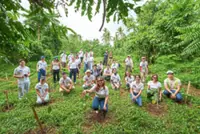Malaysia’s peatland forests hold vast biodiversity that deserves attention
In waters as acidic as vinegar—at a pH of 4—a small, resilient fish known as the Malay combtail (Belontia hasselti), meanders gracefully through the dark, tea-stained pools of the peat swamp forest. These waters are coloured by tannins released by decomposing organic matter. They are surrounded by a dense canopy of leaves and littered with the remains of fallen trees and leaves.
Welcome to the world of peatlands— one of the most remarkable yet often overlooked ecosystems on Earth.
Peatlands exist in many forms around the globe—from the moors of the United Kingdom to bogs and fens of Minnesota to the swampy lowlands of the Congo Basin. Malaysia, particularly Sarawak, is home to some of the most unique tropical peat swamp forests, where the rainforest merges with the peatland to form a unique ecosystem.
These forests are home to a treasure trove of biodiversity, many of which are found nowhere else. The acidic and waterlogged conditions have given rise to highly specialised flora and fauna that makes these forests not only biologically rich but also ecologically irreplaceable.
“Peatlands are one of the most important carbon reservoirs,” said Sarawak Tropical Peat Research Institute (TROPI) director Datu Dr Lulie Melling.
In her research on tropical peatland ecosystems, Melling highlights that Malaysia’s peatlands—covering some 2.6 million hectares, 70% of which is in Sarawak—are still largely unexplored, despite being crucial for both biodiversity conservation and climate regulation. Melling’s research showed that the peat swamp forest is influenced by its topo-hydrological characteristics which influence the water movement, within the area.
These in turn determine the vegetation structure, species composition and peat type.
Nature’s sponge and climate regulator
According to Wetlands International Malaysia, Malaysian peat swamp forests are categorised as critically endangered forested wetlands. With their deep layers of peat that act like sponges, these forests play an important role in water regulation—absorbing excess rainfall to mitigate flooding and slowly releasing the water during dry spells.
Peat also acts as a natural filter, protecting the quality of fresh water and preventing seawater from entering coastal regions. Its acidic water dictates what can survive, creating a specialised ecosystem that differs from other tropical rainforests.
Although the tree species diversity is lower compared to the dipterocarp forests, the peat swamps harbour some of the world’s most important species.
These include the orangutan, Sumatran tiger, proboscis monkey and even the elusive Sumatran rhinoceros. Sarawak’s peat domes are also home to rare trees such as the Shorea albida, a species endemic to north-west Borneo.
Lifeline for local communities
For generations, peatland forests have provided for local and indigenous communities. These ecosystems provide fish, fruits, medicinal plants, honey and materials such as mengkuang and rattan for weaving and handicrafts. Traditional herbs such as Paku Miding, Seduduk, ribu gajah are used to treat diseases, reflecting the cultural and health value of these forests.
Carbon giants
What makes peatlands even more extraordinary is their role in mitigating climate change. Although they only cover 3% of the Earth’s land surface, peatlands store twice as much carbon as all the world’s forests combined. The tannins in the water slow down decomposition so that organic material can accumulate over thousands of years, storing huge amounts of carbon.
In fact, mummified cadavers from as far back as 8,000 years ago have been found in bogs around Europe, such as the Tollund Man in Denmark, which dated back to the Iron Age.
However, this natural carbon vault is fragile. As soon as the peat is drained or disturbed, it oxidises. This releases greenhouse gases into the atmosphere. The dry peat material becomes highly flammable—fuel for wildfires and the dense haze that plagues South-East Asia.
Draining peatlands for agriculture or development not only threatens biodiversity but also undermines climate commitments and exposes low-lying areas to severe flooding.
Urgent call to conserve
There is an urgent need to preserve the remaining extensive tracts of peatland forests in Peninsular Malaysia, Sabah, and Sarawak. According to Melling, expanding agricultural development and opening new settlements pose serious threats to these ecologically rich landscapes.
A major concern is that most forms of development require draining the peatland. Once drained, the peat dries out, triggering the decomposition of accumulated organic matter and converting these vital carbon sinks into carbon sources. If left unprotected and dry, peatlands will become ecological time bombs.
Additionally, dried peatland surfaces are typically lower in elevation, increasing the risk of severe flooding.
When asked about effective strategies to conserve these unique ecosystems, Melling emphasised the importance of establishing national parks to protect biodiversity and maintain the ecological integrity of Malaysia’s peatland forests.
Malaysia’s peatland forests are not wastelands. They are living, breathing archives of the Earth’s past—and vital to its future. Protecting them is no longer a choice. It is a necessity.





